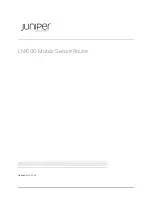
96
NetComm Wireless 4G M2M Router
www.netcommwireless.com
v1.0
Only accept authenticated SMS messages
Enables or disables checking the
sender’s phone number against
the allowed sender white list for incoming diagnostics and
command execution SMS messages.
If authentication is enabled, the router will
check if the sender’s number exists in
the white list. If it exists, the router then checks the
password (if configured) in the incoming message against the password in the white list for the corresponding sending number. If
they match, the diagnostic or command is executed.
If the number does not exist in the white list or the password does not match, the router does not execute the incoming diagnostic
or command in the SMS message.
This is enabled by default and it is strongly advised that you leave this feature enabled to maintain security.
Send Set command acknowledgement replies
The NTC-140-01 router will automatically reply to certain types of commands received, such as
get
commands, or
execute
commands. However acknowledgement replies from the NTC-140-01 router are optional with
set
commands and the
Wakeup
command. This option Enables or disables sending an acknowledgment message after execution of a
set
command or SMS
Wakeup command. If disabled, the router does not send any acknowledgement after execution of a
set
command or SMS Wakeup
command. All acknowledgment replies are stored in the Outbox after they have been sent. This can be useful to determine if a
command was received and executed by the router. This option is disabled by default.
Access advanced RDB variables
By default, this option is turned off and only allows access to the
listed later in this guide. If this option is
enabled, you are able to access the full list of RDB variables via SMS.
Allow execution of advanced commands
By default, this option is turned off and only allows execution of the
listed later in this guide. If this option is
enabled, you are able to execute advanced commands such as those which are common to the Linux command line. For example:
“execute
ls /usr/bin/sms*
” to list the contents of the /etc folder on the router.
Send acknowledgement replies to
This option allows you to specify where to send acknowledgment messages after the execution of a
set, get,
or
exec
command.
If a fixed number is selected, the acknowledgement message will be sent to the number defined in the Fixed number to send replies
to field. If
the sender’s number
is selected, the acknowledgement message will be sent to the number that the SMS diagnostic or
command message originated from. The default setting is to use
the sender’s number
.
Fixed number to send replies to
This field defines the destination number to which error messages are sent after the execution of a
get
,
set,
or
exec
command. This
field is only displayed when Send Error SMS to is set to Fixed Number.
Send command error replies
Enables or disables the sending of an error message resulting from the execution of a
get
,
set
, or
exec
command. All error replies
are stored in the Outbox after they have been sent.
Send error replies to
When Send Error SMS for Get/Set/Exec Command is set to ON, this option is used to specify where the error SMS is sent. Use the
radio buttons to select either Fixed Number or SMS Sender Number. When set to SMS Sender Number the router will reply to the
originating number of the SMS diagnostic or command. When set to Fixed Number the router will send the error messages to the
number specified in the following field.
Send a maximum number of
You can set the maximum number of acknowledgement and error messages sent when an SMS diagnostic or command is
executed. The maximum limit can be set per hour, day, week or month. The router will send a maximum of 100 replies by default.
The number of messages sent is shown below the options. The total transmitted message count resets after a reboot or at the
beginning of the time frame specified.
















































